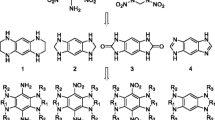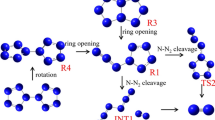Abstract
An azo bridge (–N = N–) can not only desensitize explosives but also dramatically increase their heats of formation and explosive properties. Amino and nitro are two important high energy density functional groups. Here, we present calculations on 1-nitro-1-triazene (NH2–N = N–NO2). Thermal stability and detonation parameters were predicted theoretically at CCSD(T)/6-311G* level, based on the geometries optimized at MP2/6-311G* level. It was found that the p → π conjugation interaction and the intramolecular hydrogen bonding that exist in the system together increase the thermal stability of the molecule. Moreover, the detonation parameters were evaluated to be better than those of the famous HMX and RDX. Finally, the compound was demonstrated to be a high energy density material.

Similar content being viewed by others
References
Strout DL (2004) Cage isomers of N14 and N16: nitrogen molecules that are not a multiple of six. J Phys Chem A 108(49):10911–10916
Ciezak JA, Trevino SF (2005) The inelastic neutron scattering spectra of α-3-amino-5-nitro-1,2,4-2H-triazole: experiment and DFT calculations. Chem Phys Lett 403(4–6):329–333
Chavez DE, Hiskey MA, Gilardi RD (2000) 3,3′-azobis(6-amino-1,2,4,5-tetrazine): a novel high-nitrogen energetic material. Angew Chem Int Ed 39(10):1791–1793
Kerth J, Löbbecke S (2002) Synthesis and characterization of 3,3′-azobis(6-amino-1,2,4,5-tetrazine) DAAT—a new promising nitrogen-rich compound. Propell Explos Pyrot 27(3):111–118
Lesnikovich AI, Ivashkevich OA, Levchik SV, Balabanovich AI, Gaponik PN, Kulak AA (2002) Thermal decomposition of aminotetrazoles. Thermochim Acta 388(1–2):233–251
Latypov NV, Bergman J, Langlet A, Wellmar U, Bemm U (1998) Synthesis and reactions of 1,1-diamino-2,2-dinitroethylene. Tetrahedron 54(38):11525–11536
Ye C, Shreeve JM (2008) New atom/group volume additivity method to compensate for the impact of strong hydrogen bonding on densities of energetic materials. J Chem Eng Data 53(2):520–524
Huynh M-HV, Hiskey MA, Hartline EL, Montoya DP, Gilardi R (2004) Polyazido high-nitrogen compounds: hydrazo- and Azo-1,3,5-triazine. Angew Chem Int Ed 43(37):4924–4928
Rodriguez MA, Campana CF, Rae AD, Graeber E, Morosin B (2005) Form III of 2,2′,4,4′,6,6′-hexanitroazobenzene (HNAB-III). Acta Crystallogr C 61(3):o127–o130
Wiberg N, Bayer H, Bachhuber H (1975) Isolierung von tetrazen, N4H4. Angew Chem 87(6):202–203
Corey EJ, Pasto DJ, Mock WL (1961) Chemistry of diimide ii. Stereochemistry of hydrogen transfer to carbon–carbon multiple bonds. J Am Chem Soc 83(13):2957–2958
Møller C, Plesset MS (1934) Note on an approximation treatment for many-electron systems. Phys Rev 46(7):618–622
Purvis GD, Bartlett RJ (1982) A full coupled‐cluster singles and doubles model: the inclusion of disconnected triples. J Chem Phys 76(4):1910–1918
Woon DE, Dunning TH (1993) Gaussian basis sets for use in correlated molecular calculations III. The atoms aluminum through argon. J Chem Phys 98(2):1358–1371
Rice BM, Hare JJ, Byrd EFC (2007) Accurate predictions of crystal densities using quantum mechanical molecular volumes. J Phys Chem A 111(42):10874–10879
Politzer P, Martinez J, Murray JS, Concha MC, Toro-Labbé A (2009) An electrostatic interaction correction for improved crystal density prediction. Mol Phys 107(19):2095–2101
Bulat F, Toro-Labbé A, Brinck T, Murray J, Politzer P (2010) Quantitative analysis of molecular surfaces: areas, volumes, electrostatic potentials and average local ionization energies. J Mol Model 16(11):1679–1691
Liu Y, Gong X, Wang L, Wang G, Xiao H (2011) Substituent effects on the properties related to detonation performance and sensitivity for 2,2′,4,4′,6,6′-hexanitroazobenzene derivatives. J Phys Chem A 115(9):1754–1762
Blanksby SJ, Ellison GB (2003) Bond dissociation energies of organic molecules. Acc Chem Res 36(4):255–263
Politzer P, Concha MC, Grice ME, Murray JS, Lane P (1998) Computational investigation of the structures and relative stabilities of amino/nitro derivatives of ethylene. J Mol Struct (THEOCHEM) 452(1–3):75–83
Rashkeev SN, Kuklja MM, Zerilli FJ (2003) Electronic excitations and decomposition of 1,1-diamino-2,2-dinitroethylene. Appl Phys Lett 82(9):1371–1373
Kimmel AV, Sushko PV, Shluger AL, Kuklja MM (2007) Effect of charged and excited states on the decomposition of 1,1-diamino-2,2-dinitroethylene molecules. J Chem Phys 126(23):234711–234721
Gindulytė A, Massa L, Huang L, Karle J (1999) Proposed mechanism of 1,1-diamino-dinitroethylene decomposition: a density functional theory study. J Phys Chem A 103(50):11045–11051
Huynh MHV, Hiskey MA, Pollard CJ, Montoya DP, Hartline EL, Gilardi R (2004) 4,4′,6,6′-tetra-substituted hydrazo- and Azo-1,3,5-triazines. JEnergyMater 22:217–229
Politzer P, Martinez J, Murray J, Concha M, Toro-Labbe A (2009) An electrostatic interaction correction for improved crystal density prediction. Mol Phys 107(19):2095–2101
Jianfen F, Heming X (1996) Theoretical study on pyrolysis and sensitivity of energetic compounds. (2) nitro derivatives of benzene. J Mol Struct (THEOCHEM) 365(2–3):225–229
Hervé G, Jacob G, Latypov N (2005) The reactivity of 1,1-diamino-2,2-dinitroethene (FOX-7). Tetrahedron 61(28):6743–6748
Anniyappan M, Talawar MB, Gore GM, Venugopalan S, Gandhe BR (2006) Synthesis, characterization and thermolysis of 1,1-diamino-2,2-dinitroethylene (FOX-7) and its salts. J Hazard Mater 137(2):812–819
Chung G, Schmidt MW, Gordon MS (2000) An ab initio study of potential energy surfaces for N8 isomers. J Phys Chem A 104(23):5647–5650
Akhavan J (2004) The chemistry of explosives. 2nd ed edn. Royal Society of Chemistry, Cambridge, UK
Simpson RL, Urtiew PA, Ornellas DL, Moody GL, Scribner KJ, Hoffman DM (1997) CL-20 performance exceeds that of HMX and its sensitivity is moderate. Propell Explos Pyrot 22(5):249–255
Bräse S, Gil C, Knepper K, Zimmermann V (2005) Organic azides: an exploding diversity of a unique class of compounds. Angew Chem Int Ed 44(33):5188–5240
Tosi P, Lu W, Bassi D, Tarroni R (2001) The reaction N2++N2 → N3++N from thermal to 25 eV. J Chem Phys 114(5):2149–2153
Christe KO, Wilson WW, Sheehy JA, Boatz JA (1999) N5+: a novel homoleptic polynitrogen ion as a high energy density material. Angew Chem Int Ed 38(13–14):2004–2009
Jasper S, Hammond A, Thomas J, Kidd L, Strout DL (2011) N22C2 versus N24: role of molecular curvature in determining isomer stability. J Phys Chem A 115(42):11915–11918
Casey K, Thomas J, Lambert Z, Strout DL (2009) Metal-Ion binding to high-energy N12C4. J Phys Chem A 113(27):7888–7891
Pinkston A, McAdory D, Jones J, Shields D, Langham R, Casey K, Strout DL (2008) Stability of N18C6H6: triangular versus hexagonal structure. J Phys Chem A 112(5):1090–1094
Strout DL (2006) Isomer stability of N6C6H6 cages. J Phys Chem A 110(22):7228–7231
Author information
Authors and Affiliations
Corresponding author
Rights and permissions
About this article
Cite this article
Chi, W., Yan, T. & Li, B. Is 1-nitro-1-triazene a high energy density material?. J Mol Model 20, 2362 (2014). https://doi.org/10.1007/s00894-014-2362-x
Received:
Accepted:
Published:
DOI: https://doi.org/10.1007/s00894-014-2362-x




